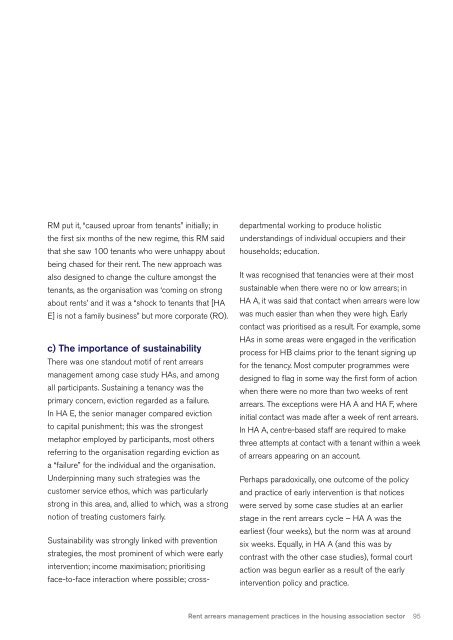Rent arrears management practices in the housing association sector
Rent arrears management practices in the housing association sector
Rent arrears management practices in the housing association sector
Create successful ePaper yourself
Turn your PDF publications into a flip-book with our unique Google optimized e-Paper software.
RM put it, “caused uproar from tenants” <strong>in</strong>itially; <strong>in</strong><br />
<strong>the</strong> first six months of <strong>the</strong> new regime, this RM said<br />
that she saw 100 tenants who were unhappy about<br />
be<strong>in</strong>g chased for <strong>the</strong>ir rent . The new approach was<br />
also designed to change <strong>the</strong> culture amongst <strong>the</strong><br />
tenants, as <strong>the</strong> organisation was ‘com<strong>in</strong>g on strong<br />
about rents’ and it was a “shock to tenants that [HA<br />
E] is not a family bus<strong>in</strong>ess” but more corporate (RO) .<br />
c) The importance of susta<strong>in</strong>ability<br />
There was one standout motif of rent <strong>arrears</strong><br />
<strong>management</strong> among case study HAs, and among<br />
all participants . Susta<strong>in</strong><strong>in</strong>g a tenancy was <strong>the</strong><br />
primary concern, eviction regarded as a failure .<br />
In HA E, <strong>the</strong> senior manager compared eviction<br />
to capital punishment; this was <strong>the</strong> strongest<br />
metaphor employed by participants, most o<strong>the</strong>rs<br />
referr<strong>in</strong>g to <strong>the</strong> organisation regard<strong>in</strong>g eviction as<br />
a “failure” for <strong>the</strong> <strong>in</strong>dividual and <strong>the</strong> organisation .<br />
Underp<strong>in</strong>n<strong>in</strong>g many such strategies was <strong>the</strong><br />
customer service ethos, which was particularly<br />
strong <strong>in</strong> this area, and, allied to which, was a strong<br />
notion of treat<strong>in</strong>g customers fairly .<br />
Susta<strong>in</strong>ability was strongly l<strong>in</strong>ked with prevention<br />
strategies, <strong>the</strong> most prom<strong>in</strong>ent of which were early<br />
<strong>in</strong>tervention; <strong>in</strong>come maximisation; prioritis<strong>in</strong>g<br />
face-to-face <strong>in</strong>teraction where possible; cross-<br />
departmental work<strong>in</strong>g to produce holistic<br />
understand<strong>in</strong>gs of <strong>in</strong>dividual occupiers and <strong>the</strong>ir<br />
households; education .<br />
It was recognised that tenancies were at <strong>the</strong>ir most<br />
susta<strong>in</strong>able when <strong>the</strong>re were no or low <strong>arrears</strong>; <strong>in</strong><br />
HA A, it was said that contact when <strong>arrears</strong> were low<br />
was much easier than when <strong>the</strong>y were high . Early<br />
contact was prioritised as a result . For example, some<br />
HAs <strong>in</strong> some areas were engaged <strong>in</strong> <strong>the</strong> verification<br />
process for HB claims prior to <strong>the</strong> tenant sign<strong>in</strong>g up<br />
for <strong>the</strong> tenancy . Most computer programmes were<br />
designed to flag <strong>in</strong> some way <strong>the</strong> first form of action<br />
when <strong>the</strong>re were no more than two weeks of rent<br />
<strong>arrears</strong> . The exceptions were HA A and HA F, where<br />
<strong>in</strong>itial contact was made after a week of rent <strong>arrears</strong> .<br />
In HA A, centre-based staff are required to make<br />
three attempts at contact with a tenant with<strong>in</strong> a week<br />
of <strong>arrears</strong> appear<strong>in</strong>g on an account .<br />
Perhaps paradoxically, one outcome of <strong>the</strong> policy<br />
and practice of early <strong>in</strong>tervention is that notices<br />
were served by some case studies at an earlier<br />
stage <strong>in</strong> <strong>the</strong> rent <strong>arrears</strong> cycle – HA A was <strong>the</strong><br />
earliest (four weeks), but <strong>the</strong> norm was at around<br />
six weeks . Equally, <strong>in</strong> HA A (and this was by<br />
contrast with <strong>the</strong> o<strong>the</strong>r case studies), formal court<br />
action was begun earlier as a result of <strong>the</strong> early<br />
<strong>in</strong>tervention policy and practice .<br />
<strong>Rent</strong> <strong>arrears</strong> <strong>management</strong> <strong>practices</strong> <strong>in</strong> <strong>the</strong> hous<strong>in</strong>g <strong>association</strong> <strong>sector</strong> 95




